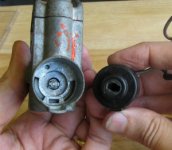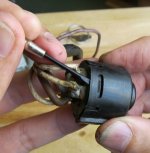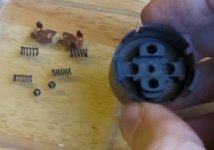No problem, I'm glad to post them. Even if it turns out you won't need 'em, someone else might; and more pics are always better!
To remove the switch from the ignition lock, there's a teeny Phillips head screw on the bottom. Remove that...
...and the plastic switch insert pulls straight out. The key tumbler ends in a small toggle, which engages a rubberized keyway on the back of the switch. With time, the keyway can get chewed up a bit.
To remove the guts of the switch, there are two small plastic tangs that need to be released. A small screwdriver works well to coax the cap out of the sleeve. (Of course, pull the cap out by the terminals, not the wires!)
The cap removed from the switch. Three things to see here -- the current is taken from the center terminal and distributed to both sides determined by the switch position; the connections can get grungy; and there are loose bits that will probably fall everywhere in the cap removal process. This is how it's
supposed to look with all in place. The balls are spring-loaded and seat into detents in the cap. That's what you feel when you "notch" the key into different positions.
The inner switch disassembled. (Note there are two spring sizes. The smaller ones go underneath the balls.) Now the inner switch can be withdrawn.
The front face of the inner switch has a spring that catches against a stop inside the shell. This is what you're pushing against when you turn the key to the start position. The stop also limits the turn of the switch. Incidentally, if your keyway is chewed up like mine was, I've had good results by trimming down toothpicks for shims and gluing them in place down in the keyway with JBWeld.
With the switch apart, you can check continuity through all the wires, and make sure the connections are being made in the different positions. It's a good opportunity to take a piece of emery paper to the copper connections and shine things up, put a schmear of dielectric grease within, and button things up knowing that at least
this component is working properly. Here's the same switch as before after cleaning:

 Hi Guest!
Hi Guest!

 smilie in place of the real @
smilie in place of the real @
 Pretty Please - add it to our Events forum(s) and add to the calendar! >>
Pretty Please - add it to our Events forum(s) and add to the calendar! >> 













